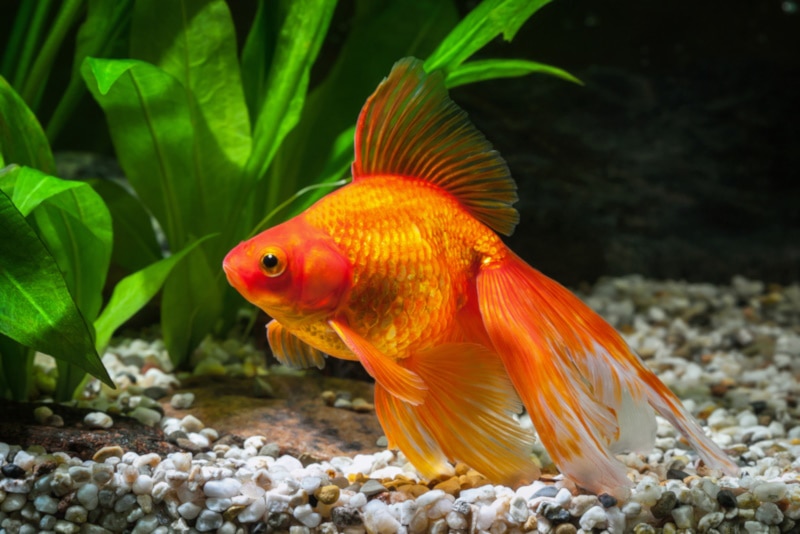Stunted Goldfish Growth: How It Happens (Vet Answer)
By Dr. Luqman Javed, DVM (Vet)
Updated on

Click to Skip Ahead
When researching pet goldfish, you may have stumbled upon information regarding stunting. Stunting is a phenomenon whereby one or several factors result in impaired growth and development.
For most people keeping fish as pets, the topic is relevant when it comes to goldfish because goldfish have been historically kept in small aquariums or bowls. As a result, people have noticed that goldfish sometimes only grow to just about a few inches in length when raised this way.
As knowledge about pet fish expands, it’s still worth understanding what stunting is, how it happens, and if it has any detrimental effects for your beloved goldfish. In this article, we’ll explore the concept of stunting in more detail.
Stunting in Fish
Stunting in fish isn’t a new concept. For fish reared for food, the topic has been researched in the past due to its economic implications; a smaller fish will likely fetch a lower price than a larger one would.
In the world of commercial fish farming, stunted growth is undesirable. Considerable efforts have been made to understand this phenomenon better and to avert it whenever possible to maximize fish growth before harvesting dates.
However, the world of pet fish has started to see interest in this area as well. Though pet fish aren’t typically kept as a food source, they are nonetheless also stunted at times. In the case of goldfish, stunting usually occurs in the first year of life, although goldfish can live for decades. And as cold-blooded animals, they don’t actually stop growing. Most of their growth occurs in the first year of life. A goldfish that is inadvertently placed in an inappropriate environment earlier in life might become stunted. Owners aren’t aware if the stunting process harms their pets or if it’s reversible.

Why Goldfish Stunt Their Growth
On the surface, stunted growth seems counterintuitive to a species. Why would goldfish have the ability to curb their own growth? A deeper understanding of their evolutionary priorities does shed some light on why goldfish (and many other species of fish) have the ability to stunt their growth in the first place.
Lack of Resources
A fish that grows quickly requires food to do so. In the absence of food, the demands of their body wouldn’t be met, and as a result, the fish would be unable to grow properly. Malnutrition would be a contributing factor to various other problems, and the fish might not be able to reproduce properly or in a timely manner.
Because fish have evolved to live in very volatile environments, where resources aren’t guaranteed, it is thought that they can stunt themselves to slow their rate of growth, thereby requiring fewer resources to maintain themselves. Therefore, they compromise on maximum size by being somewhat more robust with the ability to manage themselves when food is scarce.

Food Quality
Research suggests that omnivorous fish (such as goldfish) prioritize food quality over quantity while growing. There are times when there is appropriate food availability. However, there are far too many fish around. In this case, larger goldfish tend to produce high amounts of growth inhibition hormones and “suppress” the competition from other fish so that their needs are met.
In goldfish, this phenomenon sometimes seems to replicate itself even when food is high in quantity but low in quality. This may be a reason why some goldfish fail to attain an expected size, despite being housed in an appropriate environment.
If you're new to the world of goldfish or are an experienced goldfish keeper that loves to learn more, we recommend you check out our best-selling book, The Truth About Goldfish, on Amazon. From diagnosing illnesses and providing correct treatments to ensuring your goldies are happy with their setup and your maintenance, this book brings our blog to life in color and will help you to be the best goldfishkeeper you can be.
Survival by Reproduction
Another explanation for stunting is that fish that stunt their growths are able to mature quicker. This may help a species when it comes to survival. In times of scarce resources, the ability to preemptively become sexually mature and produce another generation to increase the odds of survival is considered an evolutionary advantage.
Interestingly, in many species of fish (including goldfish), there is no strong correlation between their size and their maturity. Some individuals can be physically smaller than their conspecifics but have the ability to reproduce.

Breeding Optimization
The ability of larger fish to stunt the growth of juvenile conspecifics is fascinating when it comes to understanding why some fish are stunted. Researchers have found that when mixed-aged groups of the same species are housed together, the mature adult males tend to produce hormones that stunt the juvenile males and prevent them from attaining sexual maturity quickly.
It has been shown that improved growth in larger males increases their relative value of reproduction later in life. Therefore, in this scenario, stunting might be a way that the fish population is ensuring that only the fittest and strongest reproduce, as there are plenty of resources available for some individuals to grow exceptionally large, and therefore, they should be reproducing.
Other Possible Reasons
The following are plausible reasons why goldfish might stunt their growth; however, these reasons have not been definitively proven as of yet, and more research needs to be done to validate these claims:
- Oxygen levels: Goldfish are coldwater fish, and while their growth is accelerated in warm water, it is found that the rate of growth isn’t optimal in this scenario because they have high oxygen level demands (cold water holds more oxygen than warm water).
- Genetics: The amount of control genetics may exert on stunting remains disputed. Though some researchers have plausible explanations as to why this might occur, researchers who studied other fish (bluegills, arctic char) didn’t find this to be the case.
How Pet Goldfish Get Stunted
There are several triggers by which stunting occurs in goldfish, though the primary mechanism is usually one of three in most of these situations.
- Goldfish, like many fish, can produce growth-inhibitory hormones, such as somatostatin. In nature, these hormones are primarily used to either compensate for unfavorable conditions or to ensure that only the best fish of a given species can breed.
- When goldfish are stressed in poorly maintained aquariums, growth-inhibiting hormones can build up and suppress the growth of the goldfish that produce them. The result is a fish that is stunted and doesn’t grow to their full potential.
- In addition to stress, several other factors (which we will discuss shortly) can contribute to the poor growth and development of goldfish, which leads to a stunted pet goldfish.

Pet Goldfish Stunting
The reasons why pet goldfish might be stunted aren’t necessarily the same as the reason why fish tend to naturally stunt their growth. The main reason for this is that goldfish that are kept as pets have none of the challenges that wild goldfish experience and, therefore, don’t need to stunt their growth when housed properly. Therefore, the reasons a pet goldfish might be stunted are usually attributed to poor management and husbandry. Let’s explore these reasons.
1. Poor Husbandry
This remains the main reason why many goldfish become stunted and don’t grow to their full size. In an aquarium that is overcrowded, poorly maintained, and not filtered enough, nitrates tend to accumulate naturally (as part of the nitrogen cycle). Though nitrates are relatively safe for fish, they can suppress the growth of fish when they are high enough. Levels higher than 20 ppm (parts per million) are considered detrimental to the long term growth and health of most pet fish, including goldfish.

2. Small Aquariums
When placed in a small aquarium, goldfish tend to get stunted. The reason isn’t the physical size of the aquarium but rather its impracticality. Maintaining water quality in a small aquarium is extremely difficult, and inevitably, goldfish become stunted due to the buildup of nitrates. Goldfish also tend to be more stressed in small aquariums and produce more growth inhibition hormones when housed in them.
Contrary to popular belief, goldfish can outgrow their tanks. In experiments, fish housed in tubes where water was constantly being replenished around them were able to continue growing until they physically couldn’t grow anymore. The size of the tubes they were housed in wasn’t restricting their growth.
Some enthusiastic fish keepers also maintain their fish this way, where a system has a constant inflow of new fresh water and an outflow of the same rate all the time. This is referred to as an open system.
The way most people keep pet fish, on the other hand, is considered a closed system, where water is in a space where it’s constantly circulating via filtration and only partially changed every week.
3. Poor Nutrition
The biological internal systems of a goldfish prioritize quality over quantity when it comes to food and its relationship to their growth. In other words, goldfish that are fed high quality foods grow much better than those that are fed lower quality foods in higher quantities. In studies comparing goldfish growth rates with different foods, researchers discovered that the quality of the food plays an important role in determining their size.
Is Stunting Harmful?
With stunted growth being attributed to natural adaptations as a response to environmental factors, the question remains whether it is harmful to goldfish if they’re stunted.
In terms of fish raised for human consumption, stunted growth is considered a negative, and the prevailing opinion is to find out its cause and to eradicate or resolve it as soon as possible to ensure that fish reach their maximum potential size.
For pet fish, though, the economical drawbacks of a smaller size are not a concern, unless you are breeding fish that you wish to market. In such a scenario, a larger size is desirable and usually fetches a greater profit.
From a purely scientific point of view, there is no definitive answer as to whether or not stunting is harmful to pet fish. It has, however, been researched that it isn’t necessarily beneficial but rather a survival mechanism. Therefore, from a humane point of view, there is no justifiable explanation for allowing your pet goldfish to be stunted.
As explained previously, goldfish can outgrow small tanks, and therefore, if you observe your goldfish stunted in a small aquarium, it means that they were unfortunately exposed to stressors that caused the stunting in the first place. Alternatively, it could also indicate that the nutritional value of the food offered to your goldfish wasn’t adequate for them. Either explanation has no reasonable justification.
Goldfish housed in adequately sized aquariums should not be stunted with appropriate stocking density aquariums and regular water quality checks alongside maintenance and healthy nutrition.

Conclusion
The phenomenon of fish becoming stunted has drawn interest from pet keepers in recent years and for good reason. Though stunting is considered an evolutionary adaptation for fish, there is no viable justification for having a pet goldfish become stunted.
Therefore, pet owners should strive to offer their pets an appropriately sized, well-maintained aquarium along with a healthy diet to ensure that they grow to their maximum potential.
See Also:
- Oldest Goldfish in the World
- How Long Do Koi Fish Live? Average Lifespan, Data & Care
- Goldfish Aquaponics Complete Guide
Featured Image Credit: dien, Shutterstock













